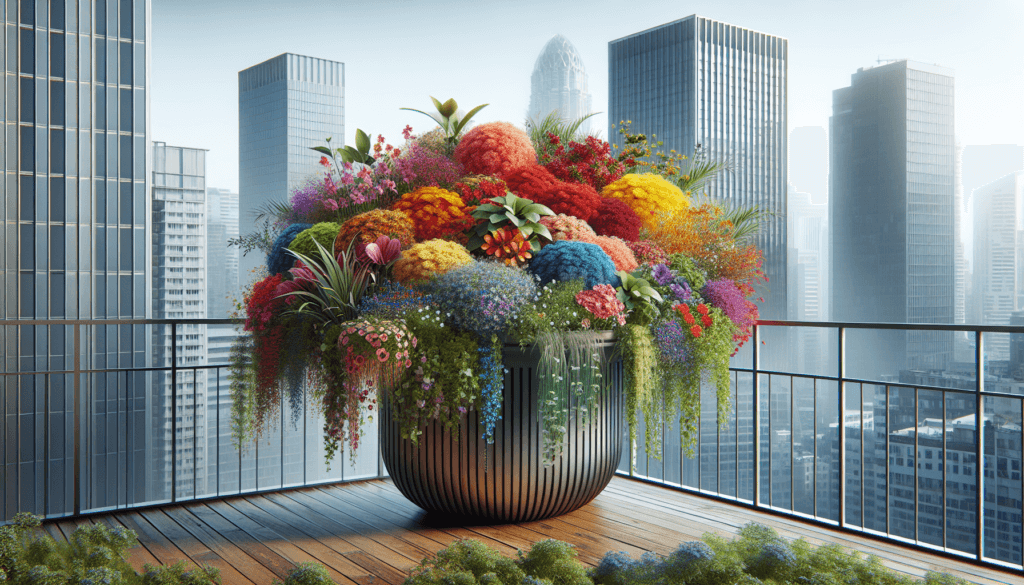Imagine stepping out onto your city balcony and being greeted by a picturesque oasis filled with vibrant flowers, lush greenery, and the calming sound of chirping birds. Creating a stunning balcony garden in the midst of the bustling urban jungle may seem like a daunting task, but fear not! In this article, we will explore the best ways to design a beautiful balcony garden that will transport you to a serene and tranquil escape, right in the heart of the city. From selecting the perfect plants to maximizing space and implementing creative design ideas, get ready to transform your balcony into a stunning haven that will leave your neighbors green with envy.

Choosing the Right Plants
When creating a balcony garden, one of the first things to consider is the climate and amount of sunlight your balcony receives. Different plants have varying sunlight and temperature requirements, so it’s important to choose plants that will thrive in your specific environment. If your balcony is shaded for most of the day, opt for plants that can tolerate low light conditions. On the other hand, if your balcony receives direct sunlight, choose sun-loving plants that can handle the heat.
Additionally, when selecting plants for your balcony garden, it’s essential to consider their suitability for container gardening. Not all plants are well-suited for growing in containers, so make sure to choose plants that have compact growth habits and don’t require extensive root systems. Look for plants specifically labeled as suitable for container gardening, as they often have smaller root systems and can adapt well to the limited space available.
Lastly, don’t forget to think about the maintenance requirements of the plants you choose. Some plants require more frequent watering, while others are more drought-tolerant. Consider your schedule and how much time and effort you are willing to dedicate to plant care. If you have a busy lifestyle, opt for low-maintenance plants that thrive with minimal attention.
Creating Vertical Space
If you have limited floor space on your balcony, don’t worry! There are several clever techniques to create vertical space and maximize your gardening area.
One effective way to utilize vertical space is by installing hanging planters. These can be suspended from the ceiling or mounted on walls, allowing you to grow cascading plants or even herbs and flowers at eye level. Hanging planters come in various sizes and designs, so you can easily find ones that match your balcony aesthetic.
Another option is to use trellises or grids for climbing plants. By attaching these structures to the walls or railing of your balcony, you can transform them into a lush green backdrop. Climbing plants such as ivy, jasmine, or bougainvillea can provide privacy and add a touch of natural beauty to your outdoor space.
For those with limited wall space, vertical shelving units can be a fantastic solution. These units can hold multiple pots or planters, allowing you to create a mini garden in a small footprint. Whether you choose metal, wood, or plastic shelves, make sure they are sturdy and able to support the weight of your chosen plants.
Utilizing Balcony Railings
The railings of your balcony can serve as an excellent opportunity to expand your garden. With a few simple additions, you can transform these often overlooked areas into vibrant and eye-catching displays.
Installing railing planters is an easy and effective way to utilize the balcony railings. These specialized planters can be securely attached and provide a space for plants to grow vertically. This not only adds beauty to your balcony but also enhances your privacy by creating a natural barrier between you and your neighbors. Fill these planters with colorful flowers, fragrant herbs, or even small vegetables to create a mini garden along your railings.
In addition to railing planters, you can use the railings themselves as a platform for hanging decorative items or lights. Hanging colorful lanterns, wind chimes, or even string lights can instantly add charm and ambiance to your balcony space. Just make sure the items you hang are securely fastened to avoid any accidents.
If you’re an herb enthusiast, consider creating a mini herb garden on the balcony railing. Install small pots or vertical planters to grow your favorite herbs within easy reach. Not only will this add a fresh culinary element to your home-cooked meals, but it also adds a splash of greenery to your balcony.
Maximizing Space with Tiered Planters
Tiered planters are a fantastic way to add depth and visual interest to your balcony garden. These multi-level planters allow you to grow a variety of plants in a compact space, making them perfect for balconies with limited surface area.
When using tiered planters, it’s essential to choose plants with different growth habits. Select a combination of trailing, upright, and bushy plants to create a visually appealing display. This combination of plant heights and textures will add depth and dimension to your garden.
Arranging the planters in an aesthetically pleasing manner is key to maximizing the impact of tiered planters. Place the largest and tallest plants at the back, and gradually work your way forward with smaller plants. This way, every plant can be seen and appreciated, and their natural beauty can shine.
To add an extra touch of drama to your balcony garden, consider adding cascading plants to your tiered planters. Plants such as trailing ivy, cascading petunias, or cascading ferns will spill over the edge of the planters and create a visually striking effect. The lush foliage trailing down the tiers will give your balcony garden a wow factor.

Choosing the Right Containers
When it comes to containers for your balcony garden, there are a few important factors to consider. The right containers can not only enhance the aesthetic appeal of your garden but also promote healthy plant growth.
First and foremost, opt for lightweight and durable containers. Since balconies often have weight limits, it’s crucial to choose containers that won’t add unnecessary weight. Materials like plastic, fiberglass, or lightweight metals are ideal choices. Additionally, make sure the containers are sturdy enough to withstand outdoor conditions, such as wind and rain.
Consider the material and drainage capabilities of the containers. Porous materials, such as terra cotta or unglazed clay, allow for better airflow to the roots and prevent waterlogging. Alternatively, if you choose containers made of non-porous materials like plastic or metal, make sure they have sufficient drainage holes to prevent water from pooling.
Another important factor to keep in mind is the size of the containers. Ensure that there is enough space for the root growth of your chosen plants. Larger plants require larger containers to accommodate their roots, while smaller plants can thrive in smaller pots. Remember to choose containers that will allow your plants to grow and flourish.
Adding Garden Accessories
To make your balcony garden truly stunning, consider incorporating some decorative elements and garden accessories. These additions can add a personal touch and create a delightful atmosphere for you to enjoy.
Incorporating decorative elements such as statues or sculptures can instantly elevate the aesthetic appeal of your balcony garden. Whether it’s a whimsical gnome, a serene Buddha statue, or a contemporary art piece, choose something that resonates with your personal taste and adds a unique touch to your outdoor space.
Hang wind chimes in your balcony garden to create a soothing and melodic ambiance. The gentle tinkling sound of chimes swaying in the breeze can bring tranquility and relaxation to your outdoor sanctuary. Choose chimes with different materials or sizes to create a harmonious and musical symphony.
Another beautiful addition to your balcony garden is small garden lights. Place these lights strategically among your plants to create an enchanting atmosphere during nighttime. Solar-powered lights are an eco-friendly option and require no wiring, making them easy to install and maintain.

Creating a Relaxation Space
Your balcony garden is not just about plants; it’s also an extension of your living space where you can relax and unwind. By incorporating comfortable seating, privacy features, and a small table, you can create a cozy and inviting outdoor oasis.
Add comfortable seating options to your balcony garden, such as a cozy lounge chair, a comfortable bench, or even a hammock if space allows. Place comfortable cushions and pillows to make the seating area more inviting and create a cozy spot for reading, sipping coffee, or simply enjoying the view.
If you desire more privacy or want to create shade, consider installing outdoor curtains. These can be attached to the walls or hung from a tension rod to create a private and intimate space. Choose curtains in light and airy fabrics to allow airflow and maintain a comfortable environment on your balcony.
Include a small table in your balcony garden for drinks or snacks. This simple addition will make your outdoor space more functional and allow you to enjoy al fresco dining or entertaining. Choose a table that fits the scale of your balcony and complements the overall design aesthetic.
Implementing a Watering System
Ensuring that your plants receive adequate water is essential for their health and growth. Implementing a proper watering system can save you time and ensure your plants receive the right amount of moisture.
Consider installing a drip irrigation system for efficient watering. This system delivers water directly to the root zone of the plants, reducing water waste and promoting healthy root growth. Drip irrigation systems can be easily installed and customized to fit the layout of your balcony garden.
For those who prefer a low-maintenance option, self-watering containers can be a game-changer. These containers have a reservoir at the bottom that holds water, allowing the plants to draw moisture as they need it. This eliminates the need for frequent watering and reduces the risk of overwatering.
If you prefer manual watering, invest in a hose with a spray nozzle. This will allow you to control the flow of water and target specific plants or areas in your balcony garden. Regularly check the moisture level of the soil and adjust your watering schedule accordingly to maintain optimal plant health.

Keeping Pests Away
Pests can be a nuisance in any garden, but there are natural ways to keep them at bay and protect your balcony garden.
Use natural repellents like essential oils or coffee grounds to deter pests. Planting herbs like basil, mint, or lavender can help repel insects due to their strong fragrance. You can also create a natural pest deterrent spray by mixing water with a few drops of essential oil, such as peppermint or eucalyptus, and spraying it on your plants.
Another effective strategy is to plant companion flowers. Some flowers, such as marigolds, chrysanthemums, or nasturtiums, release natural compounds that repel insects. Interspersing these companion flowers throughout your balcony garden can help keep pests away.
Regularly check for signs of pests and take necessary action if you spot any. Remove any troubled plants from your balcony garden to prevent the infestation from spreading. In some cases, you may need to resort to organic insecticides or pest control measures to protect your plants fully.
Maintaining the Balcony Garden
To ensure the long-term success of your balcony garden, regular maintenance is crucial. By following a few simple steps, you can keep your plants healthy and your balcony looking beautiful.
Regularly water your plants, taking care not to overwater or underwater them. Each plant has different moisture requirements, so familiarize yourself with the specific needs of each plant in your balcony garden. Monitor the soil moisture level and adjust your watering schedule accordingly.
Pruning and trimming are essential for maintaining the shape and health of your plants. Remove any dead or yellowing leaves, as well as any overgrown or damaged branches. This will not only keep your plants looking tidy but also stimulate new growth.
Lastly, keep your balcony clean and free of debris. Regularly sweep or hose down the balcony floor to remove any fallen leaves or dirt. This not only improves the visual appeal of your outdoor space but also reduces the risk of pests and diseases.
By following these maintenance practices, your balcony garden will continue to thrive and bring joy to your urban oasis.
In conclusion, designing a beautiful balcony garden in the city is both rewarding and enjoyable. By choosing the right plants, creating vertical space, utilizing balcony railings, maximizing space with tiered planters, choosing the right containers, adding garden accessories, creating a relaxation space, implementing a watering system, keeping pests away, and maintaining the garden, you can create an inviting and tranquil outdoor haven right outside your doorstep. So go ahead, let your creativity flourish, and transform your balcony into a vibrant and breathtaking sanctuary. Happy gardening!



